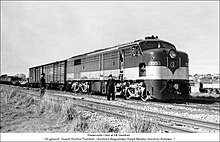South Australian Railways 930 class
| SAR 930 class | |||||||||||||||||||||||
|---|---|---|---|---|---|---|---|---|---|---|---|---|---|---|---|---|---|---|---|---|---|---|---|
 Preserved 930 at the National Railway Museum in April 2014 | |||||||||||||||||||||||
| |||||||||||||||||||||||
| |||||||||||||||||||||||
| |||||||||||||||||||||||
| |||||||||||||||||||||||
The SAR 930 class was a class of diesel-electric locomotives built by AE Goodwin, Auburn for the South Australian Railways between 1955 and 1967.
History[]

The first six single ended examples were delivered in 1955 and 1956 to operate over the steeply graded Adelaide to Tailem Bend line and onwards to Serviceton. A further 31 double ended examples entered service between July 1957 and June 1967 and operated across the broad gauge network. The double ended locomotives had a "bulldog nose" at one end, and a flat end at the other.
All were delivered with broad gauge bogies and worked across the South Australian network.[1]
In March 1978, all were included in the transfer of the South Australian Railways to Australian National. From 1982, some were converted to standard gauge using bogies from State Rail Authority 44 class locomotives hauling trains from Adelaide to Whyalla and Broken Hill.[2] On the broad gauge, some began operating through to Melbourne in the mid-1980s.[3]
In 1986, a new computer system required the class leaders of the former South Australian Railways to be renumbered as the last member of the class, with 930 becoming 967.[4]
Withdrawals commenced in 1986 with only two remaining by January 1994.[3][5][6][7] Only 961 was included in the sale of Australian National's freight operations to Australian Southern Railroad in November 1997. In May 2001 it was sold to Silverton Rail as 44s1 and in March 2005 passed to Chicago Freight Car Leasing Australia.
Survivors[]
- 930 is preserved on static display at the National Railway Museum, Port Adelaide[1]
- 958 is preserved in operational condition at SteamRanger Heritage Railway, Mount Barker[8]
- 961 was sold to the Canberra Railway Museum in November 2014 and is undergoing restoration by its new owner, the Australian Railway Historical Society. Following closure of the Museum the locomotive remains at Goulburn.
- 963 is at SteamRanger Heritage Railway in non-operational condition[9]
Bibliography[]
- A guide to Australian Locomotion. Australian Railway Historical Society. 2009. ISBN 978-0-9805106-3-8.
References[]
- ^ a b "930 class Co-Co Diesel-Electric Locomotive No. 930". National Railway Museum. Retrieved 2 May 2016.
- ^ Oberg, Leon (1984). Locomotives of Australia 1850's – 1980's. Frenchs Forest: Reed Books. p. 225. ISBN 0 730100 05 7.
- ^ a b "961 – An Alco Survivor". Railway Digest. June 1999. p. 27.
- ^ "Australian National Broken Hill Line Report". Railway Digest: 314. October 1986.
- ^ "930 Class (SA, Diesel-Electric)". Railpage. Retrieved 2 May 2016.
- ^ "930 Class". VICSIG. Retrieved 2 May 2016.
- ^ "Broad/Standard Gauge 930-class diesel locomotives". Chris's Commonwealth Railways Information. Retrieved 2 May 2016.
- ^ "Diesel Locos and Railcars". Steamranger Enthusiast Pages. Retrieved 2 May 2016.
- ^ "Rolling Stock Register". SteamRanger Enthusiast Pages. Retrieved 2 May 2016.
- A. E. Goodwin locomotives
- Co-Co locomotives
- Railway locomotives introduced in 1955
- South Australian Railways diesel locomotives
- Standard gauge locomotives of Australia
- Broad gauge locomotives in Australia
- Diesel-electric locomotives of Australia
- Streamlined diesel locomotives